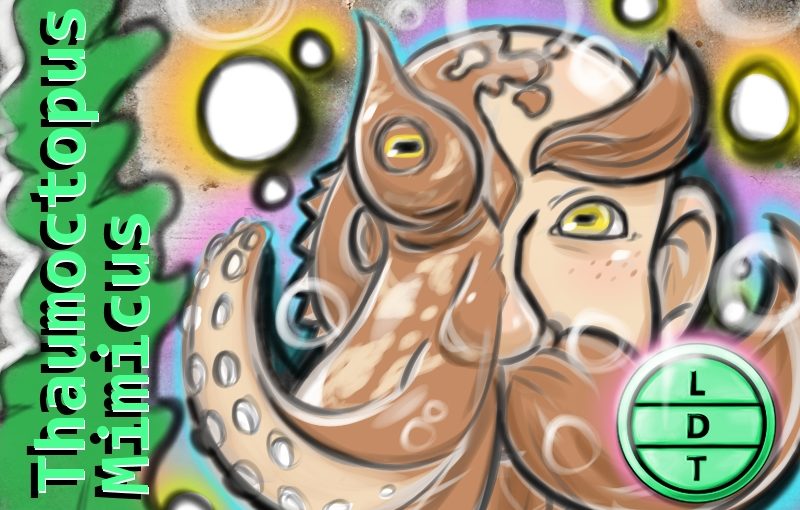“And today we are talking about a slippery sucker pup that has more than 15 ways to get out of danger.”
Lots of animals pretend to be other animals. Hiding and visual deception have helped countless butterflies, snakes, and millipedes either eat or avoid being eaten by donning masks and acting their little hearts outs. But the mimic octopus takes things to a new level. The veritable Frank Caliendo of the animal kingdom, this cephalopod has a whole rolodex of species that it can imitate. But camouflage and mimicry are just some of the many tools the mimic octopus uses to survive here in LDT.
Description
- The mimic octopus is on the small end of the octopus size spectrum.
- Their arms about the diameter of a pencil.
- They have smallish heads with long spindly legs.
- Their heads have little “horns” above each eye.
- They are normally brown and beige colors, but we will learn later that they are not always the same color.
- You may often see them with dark and light striped patterns.
- They live all over the ocean, especially in the indo-pacific ocean and around Australia.
- Most octopodes like to stick close to reefs for cover, but mimics prefer estuaires and river mouths.
Measure Up
Length – 60 cm (2 ft) – How many octopuses go into the height of the tallest point (11,411 ft) on the island of Sulawesi (sue-la-way-see)? Hint: the mimic octopus was first discovered off the coast of Sulawesi, which is the 11th largest island in the world. Answer: 5,705 octopuses
Weight – Mimic octopuses are sexually dimorphic when it comes to size and females are much bigger. Males can weigh as little as a quarter of a gram while females can weigh up to 10 kilograms or 22 pounds. – How many male mimics go into the weight of the gold (13 pounds) in the priceless Panagyurishte (Pana-ger-ish-tay) treasure found in Bulgaria in 1942? Hint: The treasure trove was found by three brothers who were digging for clay and ended up finding lost artifacts from the fourth century BC, including a drinking horn, golden decanters, a dish, and a vase used in religious ceremonies. Answer: 23,586 male mimics.
Fast Facts
- Mimics use jets of water to propel themselves along the ocean floor.
- It prefers to eat small fish, crabs, and worms.
- It’s a skilled hunter that often uses trickery to catch prey. More on that later.
- It may ambush prey but it’s also been observed stalking and chasing down prey.
- Mimics are also considered foragers because of the way the glide along the seafloor and reach into crevices to find prey.
- Foraging is a branch of behavioral ecology, that most hunters fall into.
- Except pure ambush predators, which stay in one spot and wait for prey to pass by, like spiders.
- Foragers make decisions to forage based on weighing the cost of energy versus what they can stand to gain.

